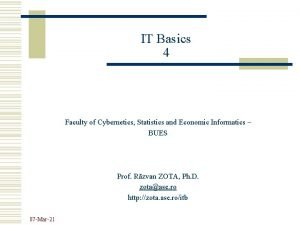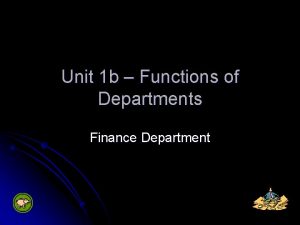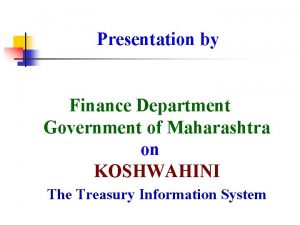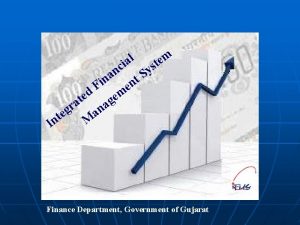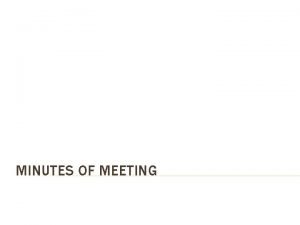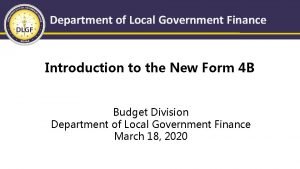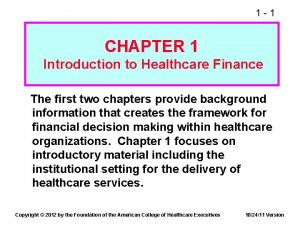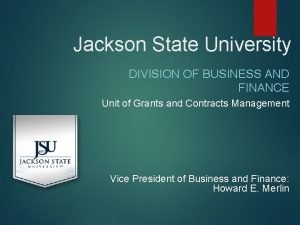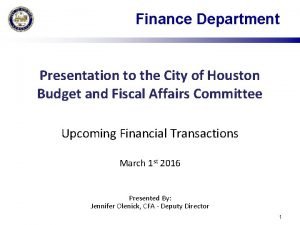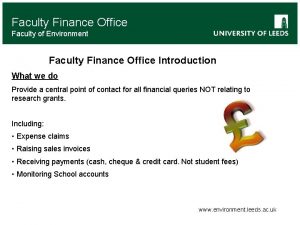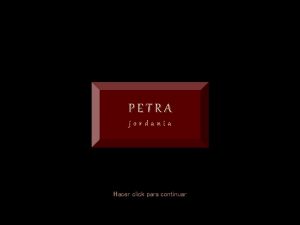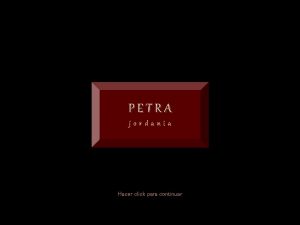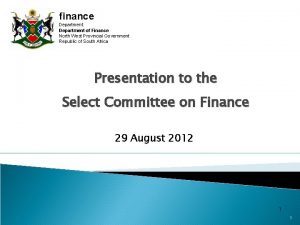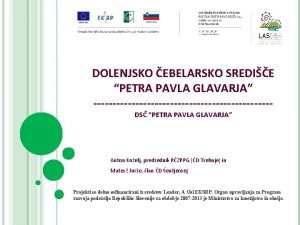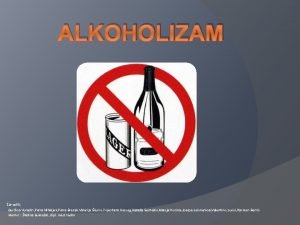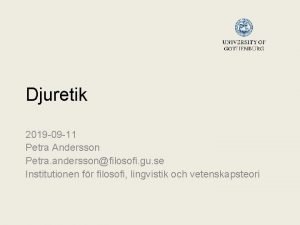Finance Program Management Department Faculty of Economic Petra












![COUNTING OF SURVIVAL BREAKEVEN � SR = [CFC/(1 – VCRR)] � CFC = adm COUNTING OF SURVIVAL BREAKEVEN � SR = [CFC/(1 – VCRR)] � CFC = adm](https://slidetodoc.com/presentation_image_h/13ac26bb9c5432e422909ff9d6eb26ec/image-13.jpg)




- Slides: 17

Finance Program Management Department Faculty of Economic Petra Christian University Surabaya 2009 MEASURING FINANCIAL PERFORMANCE

LEARNING OBJECTIVES � Describe the process for obtaining and recording resources needed for an earlystage venture � Describe and prepare a basic balance sheet � Describe and prepare a basic income statement � Explain the use of internal statements as they relate e to formal financial statement

LEARNING OBJECTIVES � Briefly describe two important internal operating schedules the cost of production schedule and the inventories schedule � Prepare a cash flow statement and explain how it helps monitor a venture’s cash position � Describe operating breakeven analysis in terms of NOPAT breakeven revenues

OBTAINING AND RECORDING THE RESOURCES NECESSARY TO START AND BUILD A NEW VENTURE DEVELOPMENT STAGE IN LIFE CYCLE BALANCE SHEET INCOME STARTUP STAGE IN LIFE CYCLE BALANCE SHEET INCOME STATEMENT Assets: Revenues: Acquire initial assets (e. g. , No sales (consequently initial cash, office no money furniture, computer, etc) Is coming in) Acquire production assets (e. g. , inventories and equipment to produce products and give credit to customer) Making sales (money begins flowing in) Liabilities and Equity: STATEMENT Assets: Obtain seed financing (e. g. , entrepreneur’s Assets, family, and friends) Revenues: Expenses: (e. g. , rent, utilities, subsistence salary for entrepreneur) Obtain startup financing (e. g. , business angels and venture capitalists in addition to seed financing sources) Expenses: (additional expenses to produce and market products and to record business transactions)

BUSINESS ASSETS, LIABILITIES, AND OWNERS’ EQUITY Assets: • Financial, physical, and intangible items owned by the business Balance sheet assets • Lists assets in declining order of liquidity, or how quickly the asset can be converted into cash

ASSETS Cash and marketable securities Receivables LIABILITIES AND EQUITY $30, 000 0 Payables $10, 000 Accrued wages 0 Inventories 10, 000 Bank loans 0 Total current assets 40, 000 Other current liabilities 0 Total current liabilities 10, 000 Long –term debts 10, 000 Gross equipment Less: Accumulated depreciation Net equipment 20, 000 0 20, 000 Building 0 Other long-term assets 0 Total assets $60, 000 Capital leases 0 Total long-term liabilities 10, 000 Owners’ equity 40, 000 Total liabilities and equity EXAMPLE OF INITIAL BALANCE SHEETS $60, 000

SALES, EXPENSES, AND PROFITS Net sales $120, 000 - Cost of goods sold (78, 000) Gross earnings 42, 000 - Marketing expenses (12, 500) - Administrative expenses (18, 000) - Building rental (6, 000) - Depreciation expenses (1, 000) Earning before interest and taxes 4, 500 -Interest (500) Earning before taxes (taxable income) 4, 000 - Taxes (25%) Net income (earning after tax) (1, 000) $ 3, 000

STATEMENT OF CASH FLOWS Cash flow from operating activities Net income $ + Depreciation 3, 000 1, 000 - Increase in receivables (50, 000) - Increase in inventories (16, 000) + Increase in payables 5, 000 + Increase in accrued wages 3, 000 Net cash flow from operating activities (54, 000) Cash flow from investing activities - Increase in gross equipment 0 Cash flow from financing activities + Increase in other short-term liabilities 25, 000 Net change excluding cash account (29, 000) Beginning cash and marketable securities Ending cash and marketable securities 30, 000 $ 1, 000

OPERATING BREAKEVEN ANALYSES Year 1 Number of units sold Year 2 Year 3 5, 000 15, 000 25, 000 500, 000 $1, 500, 000 $ 2, 500, 000 (325, 000) (975, 000) (1, 625, 000) 175, 000 525, 000 875, 000 - Administrative expenses (200, 000) - Marketing expenses (180, 000) EBITDA (205, 000) 145, 000 495, 000 (25, 000) (230, 000) 120, 000 470, 000 (20, 000) (250, 000) 100, 000 450, 000 75, 000 (30, 000) (135, 000) Revenues - Cost of goods sold Gross profit - Depreciation EBIT - Interest expenses EBT - Taxes Net income $ $ (175, 000) $ 70, 000 $ 315, 000

SURVIVAL BREAKEVEN “TERMS” � EBITDA = earning before interest, taxes, depreciation, and amortization � EBDAT = earning before depreciation, amortization, and taxes � EBDAT breakeven = amount of revenues needed to cover a venture’s cash operating expenses � Cash flow break even = cash flow at zero for a specific period (EBDAT = 0)

EXAMPLE OF EBDAT EXPERIENCE Year 1 Number of units sold Year 2 Year 3 5, 000 15, 000 25, 000 500, 000 $1, 500, 000 $ 2, 500, 000 (325, 000) (975, 000) (1, 625, 000) 175, 000 525, 000 875, 000 - Administrative expenses (200, 000) - Marketing expenses (180, 000) (20, 000) 125, 000 $ 475, 000 Revenues - Cost of goods sold (65% of revenues) Gross profit - Interest expenses EBDAT Percent of revenues $ $ (225, 000) -45% $ 8. 3% 19%

SURVIVAL REVENUES (SR) � Amount of revenues just offsetting variable and cash fixed costs (EBDAT breakeven) � EBDAT = revenues ( R ) – variables costs (VC) – cash fixed costs (CFC) � VC = variable costs revenues ratio (VCRR) x (R ) � Survival revenues (SR) = VC + CFC = SR – VC � CFC = SR – (VCRR) x (SR) � CFC = SR[1 – (VCRR)] � SR = [CFC/(1 – VCRR)]
![COUNTING OF SURVIVAL BREAKEVEN SR CFC1 VCRR CFC adm COUNTING OF SURVIVAL BREAKEVEN � SR = [CFC/(1 – VCRR)] � CFC = adm](https://slidetodoc.com/presentation_image_h/13ac26bb9c5432e422909ff9d6eb26ec/image-13.jpg)
COUNTING OF SURVIVAL BREAKEVEN � SR = [CFC/(1 – VCRR)] � CFC = adm exp + marketing exp + financing exp � CFC = $200, 000 + $180, 000 + $20, 000 � C FC = $400, 000 � VCRR = cost of goods sold/revenues � SR = $400, 000/(1 - 0. 65) � SR = $400, 000/0. 35 � SR = $1, 142, 857 = $1, 143, 000 (rounded)

CHECKING OF SURVIVAL BREAKEVEN Survival revenues - COGS (65%) Gross profit $1, 143, 000 (743, 000) 400, 000 - Administrative expenses (200, 000) - Marketing expenses (180, 000) - Interest expenses EBDAT (20, 000) 0

NOPAT BREAKEVEN � NOPAT net operating profit after taxes or EBIT times one minus the firm’s tax rate = EBIT (1 – tax rate) � NOPAT breakeven revenues (NR) amount of revenues needed to cover a venture‘s total operating costs = Total operating fixed costs (TOFC)/(1 – VCRR)

OPERATING BREAKEVEN ANALYSES Year 1 Number of units sold Year 2 Year 3 5, 000 15, 000 25, 000 500, 000 $1, 500, 000 $ 2, 500, 000 (325, 000) (975, 000) (1, 625, 000) 175, 000 525, 000 875, 000 - Administrative expenses (200, 000) - Marketing expenses (180, 000) EBITDA (205, 000) 145, 000 495, 000 (25, 000) (230, 000) 120, 000 470, 000 69, 000 (36, 000) (141, 000) (161, 000) 84, 000 329, 000 (32. 2%) 5. 6% 13. 2% Revenues - Cost of goods sold Gross profit - Depreciation EBIT - Taxes (at a 30% effective rate) NOPAT Percent of revenues $

SELESAI
 Nit calicut chemistry department
Nit calicut chemistry department Asc code
Asc code Fulbright faculty development program
Fulbright faculty development program Function of finance department
Function of finance department Koshwahini ddo pending bill
Koshwahini ddo pending bill Finance department functions
Finance department functions Finance department organizational chart
Finance department organizational chart Ms department of finance and administration
Ms department of finance and administration State of alabama department of finance
State of alabama department of finance Minutes of meeting finance department
Minutes of meeting finance department Department of local government finance
Department of local government finance Ms department of finance and administration
Ms department of finance and administration Healthcare finance department structure
Healthcare finance department structure Jackson state university finance department
Jackson state university finance department City of houston finance department
City of houston finance department Economic growth vs economic development
Economic growth vs economic development Economic development vs economic growth
Economic development vs economic growth Chapter 1 lesson 2 our economic choices worksheet answers
Chapter 1 lesson 2 our economic choices worksheet answers

